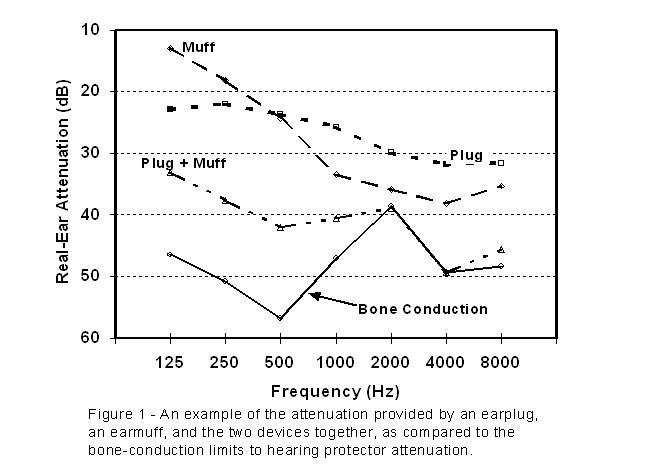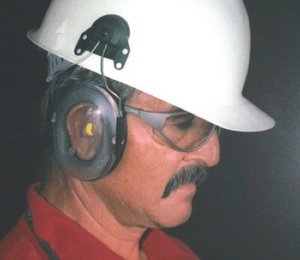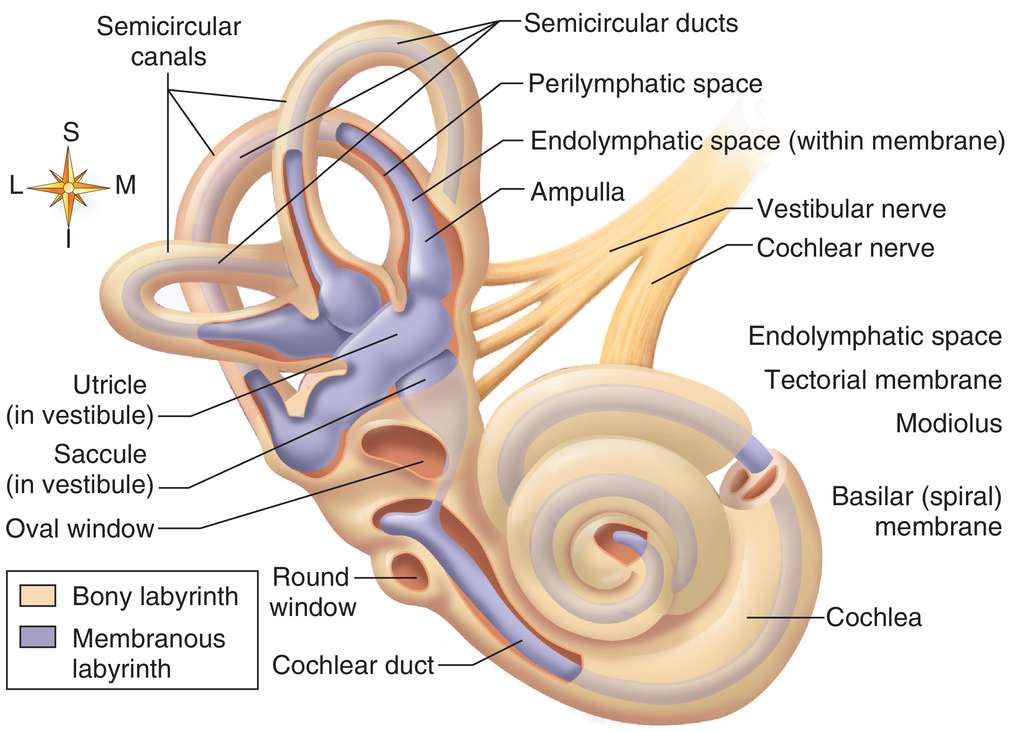
Human Ear Anatomy
What is the inner ear? The inner ear is the innermost part of the ear, which consist of the cochlea, the balance mechanism, the vestibular and the auditory nerve. Read more in this article about the inner ear’s anatomy, how the inner ear functions and the parts of the inner ear.
The inner ear is a maze of tubes and passages, referred to as the labyrinth. In the labyrinth can be found the vestibular and the cochlea.
The cochlea
The cochlea is a portion of the inner ear that looks like a snail shell (cochlea is Greek for snail.) The cochlea receives sound in the form of vibrations, which cause the stereocilia to move. The stereocilia then convert these vibrations into nerve impulses which are taken up to the brain to be interpreted.
Structural diagram of the cochlea showing how fluid pushed in at the oval window moves, deflects the cochlear partition, and bulges back out at the round window.
In the cochlea, sound waves are transformed into electrical impulses which are sent on to the brain. The brain then translates the impulses into sounds that we know and understand.
What is the cochlea and what is the function of the cochlea?
The cochlea resembles a snail shell or a wound-up hose and is filled with a fluid called perilymph and contains two closely positioned membranes. These membranes form a type of partition wall in the cochlea. However, in order for the fluid to move freely in the cochlea from one side of the partition wall to the other, the wall has a little hole in it (the helicotrema). This hole is necessary, in ensuring that the vibrations from the oval window are transmitted to all the fluid in the cochlea.
When the fluid moves inside the cochlea, thousands of microscopic hair fibres inside the partition wall are put into motion. There are approximately 24,000 of these hair fibres, arranged in four long rows.
As the fluid moves, the cochlear partition (basilar membrane and organ of Corti) moves; thousands of hair cells sense the motion via their stereocilia, and convert that motion to electrical signals that are communicated via neurotransmitters to many thousands of nerve cells.
Plus the fluid in the cochlea is a necessity for moving the hair cells and triggering the electrical impulse necessary for hearing. Air alone, especially ... Anneloes' answer is the most plausible, the cilia wouldn't move as well to excitation. ... Almost everything inside our body is fluid immersed, so that is the default situation.
However, in order for the fluid to move freely in the cochlea from one side of the partition wall to the other, the wall has a little hole in it (the helicotrema). This hole is necessary, in ensuring that the vibrations from the oval window are transmitted to all the fluid in the cochlea.
The auditory nerve
What is the auditory nerve? The auditory nerve is a bundle of nerve fibres that carry information between the cochlea in the inner ear and the brain. The function of the auditory nerve is to transmit signals from the inner ear to the brain.The hair fibres in the cochlea are all connected to the auditory nerve and, depending on the nature of the movements in the cochlear fluid, different hair fibres are put into motion.
When the hair fibres move they send electrical signals to the auditory nerve which is connected to the auditory centre of the brain. In the brain the electrical impulses are translated into sounds which we recognise and understand. As a consequence, these hair fibres are essential to our hearing ability. Should these hair fibres become damaged, then our hearing ability will deteriorate.
The vestibular – the balance mechanism
What is the vestibular? The vestibular is another important part of the inner ear. The vestibular is the organ of equilibrium. The vestibular’s function is to register the body's movements, thus ensuring that we can keep our balance.
The vestibular consists of three ring-shaped passages, oriented in three different planes. All three passages are filled with fluid that moves in accordance with the body's movements. In addition to the fluid, these passages also contain thousands of hair fibres which react to the movement of the fluid sending little impulses to the brain. The brain then decodes these impulses which are used to help the body keep its balance.
attenuation
ətɛnjʊˈeɪʃ(ə)n
noun
the reduction of the force, effect, or value of something.
"human security required the attenuation of a wide range of threats to people"
-the reduction of the amplitude of a signal, electric current, or other oscillation.
-
"the products are used mostly by aircraft manufacturers for noise attenuation in engine housings"
Extra Protection: Wearing Earmuffs and Earplugs in Combination
INTRODUCTION:
When it's really loud, so loud that a properly worn single hearing protection device (HPD) can't provide safe listening, what is a hearing conservationist to do? Reducing exposure time or other administrative controls are certainly options to consider. Another option may well be the use of earmuffs and earplugs in combination, commonly called 'dual protection.' As you probably guessed, dual protection has its own assets, liabilities, and limitations. This article will explore them.
OVERVIEW:
It is generally recommended that one should consider the use of dual protection when 8-hour time-weighted-average (TWA) exposures exceed 105 dBA as required in the new Mine Safety and Health Administration (MSHA, 1999) noise regulation, which went into effect September, 2000. For an extra margin of safety one may wish to consider implementation of dual protection when exposures exceed 100 dBA as is suggested in the 1998 NIOSH Revised Criteria for Occupational Noise Exposure. Using dual protection at levels or exposures below that is problematic due to interference with speech-based communication. However, once noise levels exceed 100 dBA unaided speech communication (i.e. communication without electronic amplifiers and earphones) is nearly impossible anyway. Therefore, no additional detriment is created by the extra protection.
Other difficulties in mandating the use of dual protection in lower-level noise include motivating employees to wear devices properly, and subsequent enforcement of their use. Although the 'annoyance' of a sound is not a good measure of its potential hazard or the need for hearing protection, its annoyance (or lack thereof) can substantially impact the ease with which use of HPDs can be mandated and effectively enforced. For many, exposures below 100 dBA just don't seem loud enough or annoying enough to warrant single protection -- let alone dual protection! If the sounds are not annoying, insisting on use of dual protection can be considerably more difficult than trying to obtain compliance with the use of a single product alone.
PERFORMANCE CONSIDERATIONS:
Earplugs worn in combination with earmuffs, helmets, or communications headsets, typically provide greater protection than either device alone. However, the attenuation of the combination is not equal to ...

[Figure 1 - An example of the attenuation provided by an earplug, and earmuff, and the two devices together, as compared to the bone-conduction limits to hearing protector attenuation (the reduction of the force, effect, or value of something.)]
...the sum of the individual attenuation values (Berger, 1983), as illustrated in Figure 1. Note for example; at 1000 Hz the combination of a 26-dB plug and a 34-dB muff does not yield 60-dB overall, but rather about 41 dB. The principal reason is the bone-conduction (BC) limits to attenuation, which are also illustrated in Figure 1. The BC limits represent sound that effectively flanks or bypasses the HPD to directly stimulate the middle and inner ears of the wearer. Another limitation on the performance of dual protection is that the plug and muff interact mechanically with each other, and thus do not behave as two completely independent attenuators.
No empirical or theoretically derived equations are available that can predict the attenuation of an earplug and earmuff combination with sufficient accuracy to be useful. At individual frequencies the incremental gain in performance for dual hearing protection varies from approximately 0 to 15 dB over the better single device, but because of the dip in BC limits at 2000 Hz, the gain varies from 0 to only a few decibels at that frequency. Attenuation changes very little when different earmuffs are used with the same earplug, but for a given earmuff the choice of earplug is critical for attenuation at frequencies below 2000 Hz. At and above 2000 Hz, all dual-protection combinations provide attenuation essentially equal to the limitations imposed by the bone-conduction pathways, approximately 40 to 50 dB, depending upon frequency. As a rule of thumb, the OSHA procedure of computing the dual protection by adding 5 dB to the Noise Reduction Rating (NRR) of the more protective of the two devices is a reasonable approximation.
For the best estimate of dual-protection performance a real-ear attenuation at threshold measurement of the combination being evaluated should be conducted. Some manufacturers of hearing protectors can provide such data. Better yet, real-world attenuation values should be considered (Berger, 2000). Unfortunately few of those types of data are available. One study, of which the author is aware, suggests that the highest attenuation in terms of an NRR-like number, that can realistically be obtained for about 84% of the population, is about 25 dB (Hachey and Roberts, 1983). This was observed in one study of a foam earplug worn in combination with a small-volume plastic earmuff. Thus when TWAs exceed about 110 dB, even dual protection is likely to be inadequate. At such times, limited durations of exposure and twice-annual monitoring audiometry should be considered.
The use of dual HPDs is especially recommended when high-intensity noise is dominated by energy at or below 500 Hz since it is in this frequency range that the attenuation of single HPDs will be the least and the potential benefits from dual protection are the greatest.
APPLICATION CONSIDERATIONS:
For maximum protection not only must a muff and plug be worn together, but both devices must be worn correctly and consistently. Even short periods of disuse can dramatically reduce the effective protection. At low frequencies, the earplug can be the most important part of the combination and thus its correct use is vital. Individual training is especially important for the high-noise otohazardous areas in which dual protection is likely to be worn.
Another issue is the ability to monitor correct usage. This is complicated once the muff is in place since the fit of the plug cannot be readily assessed by supervisors unless they stop and ask the employee to lift one or both earmuff cups. In fact, when dual protection is apparently being used, whether or not the plug is actually being worn at all cannot be ascertained by simple passing observation.
For maximum protection not only must a muff and plug be worn together, but both devices must be worn correctly and consistently. Even short periods of disuse can dramatically reduce the effective protection. At low frequencies, the earplug can be the most important part of the combination and thus its correct use is vital. Individual training is especially important for the high-noise otohazardous areas in which dual protection is likely to be worn.
Another issue is the ability to monitor correct usage. This is complicated once the muff is in place since the fit of the plug cannot be readily assessed by supervisors unless they stop and ask the employee to lift one or both earmuff cups. In fact, when dual protection is apparently being used, whether or not the plug is actually being worn at all cannot be ascertained by simple passing observation.
An interesting solution to this problem has recently been provided by one manufacturer in the form of clear earmuffs with a special donut-shaped foam absorber inside that allows clear viewing of the earplug (see Figure 2).
The absorber has been designed so as not to degrade the earmuff's attenuation, so that even if the muff is worn alone, it functions as well as its standard opaque counterpart.

Figure 2: A new style of dual protection that incorporates the use of a foam earplug worn under a clear earmuff cup (Peltor/E#149;A#149;R High Performance Series).
CONCLUDING REMARKS:
It has been observed that 97% of industrial noise exposures are less than 100 dBA TWA. Therefore, in most cases, dual protection is not going to be necessary or appropriate. However, for those situations in which noise exceeds 100 dBA, as found in a wide range of industries from on-line aircraft engine maintenance to metal riveting, dual protection may be an appropriate solution.
Although the casual observer of HPD's labeled NRRs might conclude that in almost any noise exposure employees will be adequately protected (because labeled NRRs commonly range from 22 - 33 dB), that is far from the actual case. Many studies in the past 20 years have clearly demonstrated that in real-world environments HPD attenuation falls far short of the EPA-mandated NRRs that have appeared on packaging since the early 1980s (Berger et al., 1996). Thus in critical high-noise instances, where TWAs exceed 100 to 105 dBA, the use of dual hearing protection is warranted.
REFERENCES:
Acknowledgment: This article was originally prepared for Occupational Health & Safety magazine's October 2000 issue. The author and the editor of OH&S have graciously allowed Audiology Online to re-edit and republish this paper here, for educational purposes. We are grateful to Mr. Berger (author)and Mr. Laws (editor) for their approval and kindness in this project.



No comments:
Post a Comment